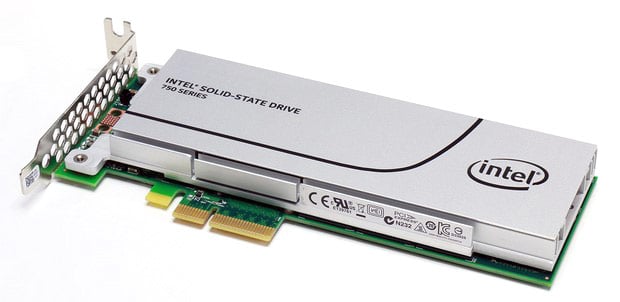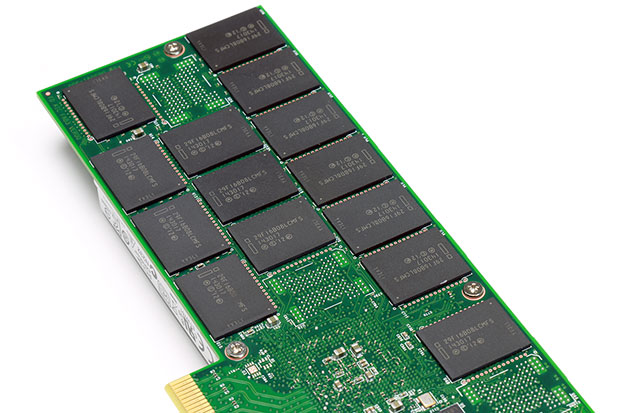Intel SSD 750 Series PCIe SSD Review: NVMe For Desktop Performance
Intel SSD 750 Series Design And Architecture
As we've noted previously, the SSD 750 is a half-height card and as such will drop into a 2U server or small form factor setup easily. However, you'll need to remove its half-height bracket and install an included full-height bracket on the back end of the card, if you plan to install it in a standard ATX chassis.
The top side of the card has a single aluminum heat spreader that spans almost the entire length of the card and is covered with a simple aluminum plate with a black, painted Intel logo and model branding on top.




Intel is offering 400GB and 1.2TB capacities, as well as PCIe cards and 2.5" PCIe Drives



The top side of the card has a single aluminum heat spreader that spans almost the entire length of the card and is covered with a simple aluminum plate with a black, painted Intel logo and model branding on top.


The PCB design is very elegant and densely packed with ICs. Our 1.2TB model is built with three primary chip types - a bit of Micron DRAM, Intel's NVMe controller (which is hiding under the heat spreader, though you can locate the bottom side of its board keep-out area with PCIe board traces going down to the card edge), and 32 Intel 20nm MLC NAND Flash packages. Our contacts at Intel tell us that there are "86 NAND die overall (multi-die packages) in this configuration, which is about 1350GB of raw NAND capacity, with two die that are used exclusively for XOR redundancy (so that user data can be recovered in the event of a single die failure)." So this 1.2TB card has about 150GB of NAND Flash over-provisioned for wear-leveling and maintenance.

Intel isn't just building PCI Express SSDs with this new technology; the SSD 750 will also come in a 2.5-inch NVMe version with SFF-8639 connectors on the back side edge, which is an extension of the 8482 SAS connector that supports higher signal quality requirements for 12Gb/s SAS and PCIe Gen 3 connections. In this case, the connector will support 4 lanes of PCI Express Gen 3 connectivity.

Intel is offering 400GB and 1.2TB capacities, as well as PCIe cards and 2.5" PCIe Drives

Here you can see the SFF-8639 cable and drive backplane connector at one end and the SFF-8643 PCIe motherboard connector. Obviously, motherboards will have to be equipped with SFF-8643 connectors eventually, but as you can see, there are both right angle and vertical versions of the connector for neat and tidy cable routing. In the meantime, we've got the PCI Express card version in for testing and when connected to an X4 slot hanging off the CPU root, you'll get full bandwidth performance. Incidentally, the 2.5" drive's 8639 connector also supports SATA, SATA Express, SAS and PCIe. The cable connector in the slide above, is a PCIe type connector.


And so, again, other than a couple of small Micron DRAM chips and some passive components, the SSD 750 is an all-Intel affair. It's impressive to see what the company was able to pack into a PCI Express SSD for the price and with its expected performance, which we'll delve into on the pages ahead.






